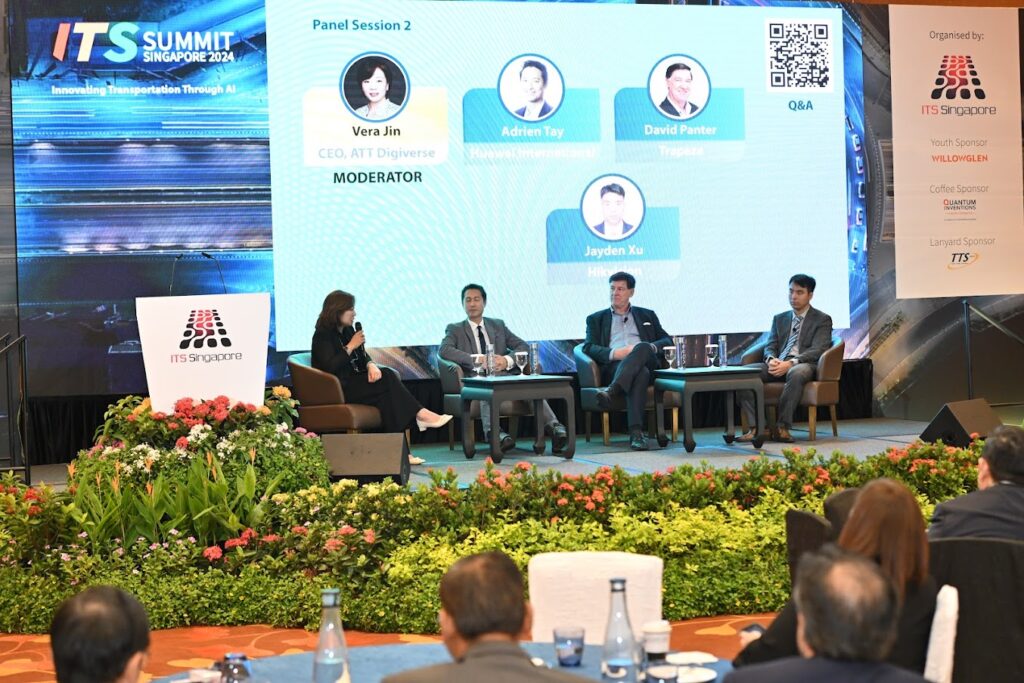Resource Hub
Leveraging AI to future proof Singapore’s bus network
Published August 06, 2024 in Blog
In July 2024, Trapeze’s Industry Solutions Manager ITS, David Panter, spoke at the Intelligent Transportation Society Singapore summit themed as ‘Innovating Transportation through AI.’
This blog shares highlights from his presentation, focusing on the ways Trapeze is using AI to drive network performance, improve maintenance, and deliver more gains for LTA in the future.
Improved passenger information
Bus tracking has always had large data sets on when a service arrives at each stopping point, the dwell time at the stop, and how many people get on or get off. Now AI can use these to generate a more accurate prediction of bus stop arrival times.
This involves machine learning to look at transit time across each link in the network and the dwell times at each stop, on a day-by-day basis and in the short term. These ML predictions are blended and compared with reality. This more reliable information increases trust from passengers, which contributes to passenger satisfaction and ultimately to improved ridership.
Trapeze is also considering how weather and traffic lights relate to performance outcomes. We know that weather has a major impact on traffic and passengers, as a tropical downpour at lunchtime slows down the traffic and drives more people onto buses to stay out of the rain.
Including weather across multiple geographic zones makes the prediction model even more accurate. Even subtle weather changes have an impact, and ML has the capacity to track changes over time and incorporate this into its prediction model.
Traffic lights just prior to a stop can also significantly impact arrival times. A bus might be held for up to 90 seconds at the lights, and this delay was not allowed for in the mid-term predictions. So, if we have the green light timing information for when we predict the vehicle will reach the intersection, AI can be used to further refine the predicted time of arrival.
Better service controls
At a more personal level, each bus operator has service controllers manageing their fleet in real time by responding to breakdowns, accidents, or other incidents that can seriously impact bus operations.
These key employees need to act quickly and decisively. Are they better off turning a trip short, or cancelling the rest of the trip and using that bus to cover another route that is running extremely late? Even the most experienced controllers get decisions wrong sometimes.
AI can empower them with the information required to make better decisions, minimising the impact of disruptions and ultimately improving performance against KPIs. When an action is taken, this can be immediately folded into the predictions and sent out to passengers, so the contracted performance is maintained, and passengers receive better service.

Bus availability and predictive maintenance
The traditional preventive maintenance approach assumes a failure pattern that increases with age and use. Maintenance routines are applied in an expected timely manner to minimise the risk of failure, but this approach only applies to 18% of assets as the remaining 82% display more random failure patterns.
Pulling out a module for testing every 12 weeks is costly, and in some cases the very act of inspecting a part may cause failure. For instance, pulling a connector and then reconnecting it increases the chance of bending a pin. Condition monitoring improves this by looking at equipment and processes on a more regular basis.
By doing this in real time and incorporating machine learning, we can predict failures before they stop the bus operating. In the case of oil pressure, monitoring patterns might show that a 5% monthly increase indicates an imminent oil pump failure, allowing a swap to be scheduled prior to failure.
You certainly don’t need ML to determine that a door open sensor has failed, but what about an intermittent signal? ML can identify patterns of use as the bus travels along its route, separating device faults like a failing sensor from environmental issues like poor local GPS coverage. This information is then used to detect devices that are in fact faulty.
New service innovations
Scheduling today is based on the bus taking a fixed amount of time to transit a link in the network. The reality is that transit times and dwell times are subject to statistical variation. With the power of ML, we could build timetables that account for this statistical variation, allowing us to provide more reliable services and improving efficiency.
Trapeze is also investigating how deep learning models can provide intelligent travel advice. We have run experiments with an operator in England that provided detailed travel plans using a combination of existing journey planners, local knowledge, and travellers’ details. This showed us that understanding each customer is important to give the right output. For instance, the best travel outcome for a fit 20-year-old might be very different to a 70-year-old using a walking stick.
Our current and future focus on passenger needs is an exciting reality, and AI is the tool that helps us meet these needs by improving bus arrival predictions, maintenance predictions, and vehicle reliability. It follows the iterative process shown here, making journeys easier through better information provision and by giving service controllers better tools to manage the network.
The Australian future
The Trapeze team is looking forward to applying the lessons learned from Singapore in other regions, including here in Australia. If you are interested in learning more about AI and our ITS solutions, please get in touch to start the conversation.
Mode of Transport
Public Transport Authorities, Ferry, Trams/Light Rail, Bus
Solutions
Intelligent Transport Systems